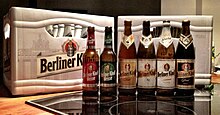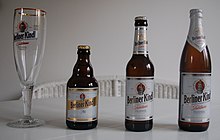Berliner Kindl
| Berliner Kindl | |
|---|---|

|
|
| Owner / user | Radeberger Group |
| Introductory year | 1872 |
| Products | beer |
| Markets | Germany |
| Website | www.berliner-kindl.de |
Berliner Kindl is a beer brand for the Oetker group belonging Berliner-Kindl-Schultheiss brewery . The brand goes back to the brewery founded in Rixdorf in 1872 as the club brewery Berliner Gastwirte zu Berlin AG . In 1910 it was renamed Berliner Kindl Brauerei-Aktiengesellschaft .
The golden boy in the jug has symbolized the Berliner Kindl since 1907 .
history


Founding years
On February 1, 1872, the innkeepers Peter Joseph Linke, Philipp Jaeger, Ernst Baumbach, Franz Specht and Fritz Schmiedel, the businessman Heinrich Mestern, the bank director Otto Swoboda and Bernhard Heßlein founded the Berliner Gastwirtte brewery in Rixdorf at Hermannstrasse 214 and Rollbergstrasse in Rixdorf AG . Their goal was to brew bottom-fermented beer . In northern Germany , the production of bottom-fermenting yeast was difficult at that time, as it requires an ambient temperature between 4 and 9 ° C, but the development of the refrigeration machine was not yet very advanced. Georg Leonhard Hopf and businessman F. W. Fanta failed in their first attempt with ice cellars in Friedrichstrasse 126 (today: the seat of the Ullstein publishing house ) because of the high groundwater level , whereas Hopf's second attempt was a success: “Now, in 1838, Berlin will get through the former Bavarian wine cooper Hopf brewed beer in the Bavarian style for the first time and served it in his localities on Tempelhofer Berg. "
With its share capital of one million thalers (Prussian: Kurant ), the club brewery acquired properties on the corner of Jägerstrasse in Berlin, on which they had buildings built for ancillary businesses in addition to the facilities required for brewing operations. Despite unfinished construction work, the brewery was opened on March 1, 1873. The first beer was released on March 17, 1873.
After the name was changed to the Rixdorf Brewery , it was possible in 1889/1890 to achieve the desired production of one hundred thousand hectoliters (hl) of beer. At the beginning of the 1890s, the production of a Bavarian-Munich-style special beer called Berliner Kindl began . This soon enjoyed great popularity and led to the two hundred thousand hectolitre mark being exceeded. The name of the beer made reference to the coat of arms of Munich that became popular in the 19th century under the name Münchner Kindl , possibly also to the Münchner-Kindl brewery named after it .
In order to make the brand symbol more contemporary, a competition was started in 1907, in which the design by Georgräder won. Since then, the golden boy in the mug has been the trademark of the brewery.
From 1909, the focus was on the production of Berliner Kindl with an original wort content of 13 percent. On December 17, 1910, the general assembly of the Rixdorf brewery decided to change its name to Berliner Kindl Brauerei-Aktiengesellschaft . The newly renamed brewery began to buy up around 20 smaller breweries. This trend was to become evident later, especially in the “ Roaring Twenties ”.
The First World War and its consequences
The situation of the company deteriorated during the First World War . The quota of malt consumption and the lack of labor, raw materials and fuels led to restrictions in production.
With the sale of two breweries in 1920 an economic stabilization was achieved. Department II in Potsdam resumed operations and enabled an annual production of 1.1 million hectoliters of Berliner Kindl. From then on things went up again. Despite or because of the global economic crisis , the brewery was in the black and was able to expand its operations. This apparent contradiction can be justified with the increased alcohol consumption of the unemployed.
The National Socialist Office for the Beauty of Work awarded the company the National Socialist Model Company seal . Later sales difficulties were compensated with a non-working Wednesday.
Destruction during World War II
The Second World War hit the brewery even harder. Half of the vehicle fleet and many employees were drafted into military service. However, the Berlin public transport company was able to help out and take over the delivery of the beer by tram. As a result of the rationing in 1941, the original wort content had to be reduced to eight percent.
In June 1944, the brewery buildings near Tempelhof Airport were badly damaged in air raids by the Allies . Prisoners of war were used to clear the rubble and transport the beer away. Operation was resumed as early as July.
post war period

The post-war years were also unpleasant for the Kindl brewery. Since Germany had to pay reparations to the Soviet Union , large parts of the breweries were dismantled. A completely new brewery was created in Moscow .
The Berlin facilities could only be makeshiftly completed through barter deals and finally resumed operations in 1947: the first two hectoliters on the day it reopened, however, came from the Berliner Bürgerbräu brewery.
Before the Second World War, breweries in what was then the Weißensee district were also part of the group. Due to the division of Berlin , these facilities and the works in Potsdam fell to the GDR . Department I in Neukölln was completely rebuilt and modernized.
The company took out loans from German banks in 1955 and received American construction aid. This and the acquisition of the Schöneberger Schlossbrauerei in the previous year ensured a further upswing of the company; Finally, in 1972 - just in time for the 100th anniversary - the former record of one million hectoliters of Kindl beer was reached again.
Already in the 1950s Berliner Kindl was majority owned by the Oetker Group . In 1988 the Binding Group took over the majority stake in Berliner Kindl Brauerei AG .
Finally, after the reunification of Berlin, the Potsdam brewery (old department II) was reintegrated and the operating part of the former Kindl brewery Weißensee (since 2001 part of the Alt-Hohenschönhausen district ) became property of the group via Brau & Brunnen in 2004 back.
21st century
The Potsdam brewery was closed again on December 31, 2002. Furthermore, the parent company Oetker decided in 2005 to close Department I in Neukölln and relocate it to the already existing brewery factory in Alt-Hohenschönhausen (Indira-Gandhi-Straße). At the same time, minority shareholders were excluded . This ended the company's listing on the stock exchange . In January 2006 the Berliner Kindl Brauerei AG was merged into the Berliner-Kindl-Schultheiss-Brauerei GmbH.
On the meanwhile to Heag Dr. Henke Projektentwicklungsgesellschaft sold the site at Werbellinstraße 50 in Neukölln, a large shopping center was planned in which cultural events were also to be held. In June 2007, a theater performance of Wallenstein took place in the former beer warehouse . The former brewhouse on the site from 1926 to 1930 is partially a listed building and should be preserved in any case. The Rollberg private brewery has been brewing there again since December 2009 and the Berliner Unterwelten association offers tours through the storage cellars.
Sponsorship
Berliner Kindl has been an advertising partner of the first handball Bundesliga team, Füchse Berlin , since 2008 and of the Bundesliga soccer team Hertha BSC since 2018 . Small soccer clubs are also supported.
Berliner Kindl was the “official premium partner” at the celebrations for the Day of German Unity and New Year's Eve at the Brandenburg Gate . The Kindl stage in Berlin's Wuhlheide , the Potsdam Palace Night , the Pyronale and the Berlin Festival of Lights are also sponsored by the beer manufacturer .
Products
The Berliner Kindl Pils makes up the largest share of the group turnover . According to the manufacturer, it was the market leader in the Berlin / Brandenburg metropolitan region around the turn of the millennium . The brewery has not published exact sales figures since the beginning of 2007.
The light bottom-fermented full beer Berliner Kindl Jubiläums Pilsener is valued as the best product in the Kindl range. According to the manufacturer, the beer called Jubi has an "extra fine hop aroma". The variety, introduced for the city anniversary in 1987 , has won the highest award in gold from the German Agricultural Society several times .
The top-fermented draft beer Berliner Kindl Weisse with an alcohol content of 3% vol. Is brewed with barley and wheat malt and only mixed with lactic acid bacteria , so that it is no longer a traditional Berliner Weisse . Variants mixed with syrup include Berliner Kindl Weisse with a dash of raspberry and Berliner Kindl Weisse with a dash of Waldmeister .
There is also the bock beers Berliner Kindl Bock dark and Berliner Kindl Bock Hell and the cyclists naturtrüb Berliner Kindl Radler . Märkischer Landmann Schwarzbier and Potsdamer Rex Pils are visually different from the Kindl range, but they belong to the same brewery. The Berliner Kindl Zwickel Naturtrüb has been produced since the beginning of 2016 .
The beers Bärenpils , Berliner Kindl Habels Maibock and Berliner Kindl Johanniter have since been discontinued.
Kindl also offers Rixdorfer Fassbrause .
literature
- Willi Glaser: 125 years of “Berliner Kindl” . In: Berlin monthly magazine ( Luisenstädtischer Bildungsverein ) . Issue 4, 1997, ISSN 0944-5560 , p. 84-98 ( luise-berlin.de ).
Web links
- Website of the Kindl brewery
- Historical labels of the Kindl brewery Berlin-Weissensee and the association brewery Rixdorf / Kindl brewery
- Company history on the Radeberger Group's website
- Early documents and newspaper articles on the Berliner Kindl in the 20th century press kit of the ZBW - Leibniz Information Center for Economics .
Individual evidence
- ^ Gustav Stresemann : The development of the Berlin bottled beer business . Dissertation. Leipzig 1900.
- ↑ Conversion - once different . In: Die Zeit , No. 1/1960.
- ↑ Claudia Keller, Lars von Törne: Zapfenstreich in Neukölln . In: tagesspiegel.de , February 2, 2005. As of November 24, 2014.
- ↑ Gabi Zylla: Brandauer brings high culture to old Neukölln brewery. ( Memento from September 30, 2007 in the Internet Archive ) In: Berliner Morgenpost . March 30, 2007.
- ↑ Liquid things for the neighborhood . In: The daily newspaper . November 30, 2010.
Coordinates: 52 ° 28 ′ 45.7 " N , 13 ° 25 ′ 54.4" E



